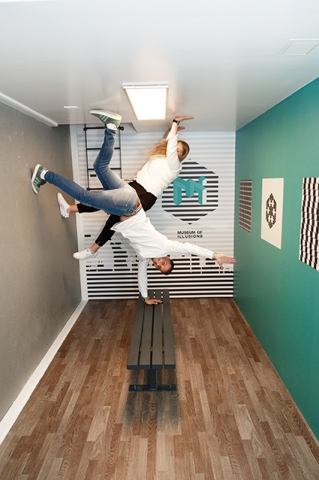Illusions Museum to Open in Tbilisi
This is a space where you can laugh, scream, take pictures and do many other things that are usually forbidden in museums.
In the historical and tourist part of Tbilisi, the globally renowned Illusions Museum is to open a branch at 10 Bethlehem Street on March 9. It is set to offer many interesting visual and intellectual experiences, combining perspectives, optical and other types of illusion, and a “play room” where visitors can try out some didactic games.
The first Illusions Museum opened in Zagreb, the capital of Croatia, in 2015. This was soon followed by openings in the Zadar Museum, Ljubljana, Vienna, Muscat, Belgrade, Kuala Lumpur, New York, Toronto, Berlin, Athens, Dubai, Hamburg, Kansas, and now Tbilisi makes it 23.
Head along with your kids or friends and learn about human vision, perception and science through the static and interactive installations. The concept of the Illusion Museum is radically different from the classical understanding of the word "museum" and it offers a unique new space that is designed for entertaining cognition. The Illusion Museum’s illusion collection aims to simultaneously encourage an observer, surprise and make them think about their own feelings.
The opening of one in Georgia was thanks to Sarke Group.
“Our original idea in 2016 was to set up a ‘Holozeum’, or hologram museum, with co-funding from Startup Georgia,” said Natalie Ananiashvili, Head of Marketing of Sarke Group. “That project was a miniature of what it is today. We chose a museum building and saw that the potential was much greater than just a Holozeum, and so the idea for the Illusion Museum came about.”
She notes that visitors can find out about human vision, perception and science through attractive and entertaining installations.
“The museum also has a gaming room and a souvenir shop where visitors of all ages can play, compete, learn something new and buy original gifts such as fun wooden didactic toys and puzzles that develop and stimulate creativity.
“The museum collection consists of more than 70 exhibits based on knowledge of science, mathematics, biology and psychology. You can find information and explanations about installations next to the exhibits. The narrative language will be Georgian, English and Russian. The technical support for the museum in Tbilisi comes from our Croatian counterparts. The exhibits have already arrived from different cities and are being installed ahead of the March 9th opening,” Ananiashvili says.
The museum is intended for all generations and will have the facilities to host birthday parties for 5-15-year-olds, with a program including a tour of the museum, didactic games and puzzles. Corporate events, meetings and presentations will also be possible.
“The Tbilisi Illusions Museum is part of a global project and does not differ from one country to another,” Ananiashvili notes. “The only difference is in the format size. In relatively small museums, there is naturally not enough space to exhibit every room or attraction that other bigger museums have [in the other 22 countries]. Yet the Tbilisi museum format is more then 400 m2 and so will offer visitors the complete collection of Illusion Museum exhibits.”
By Mariam Merabishvili












